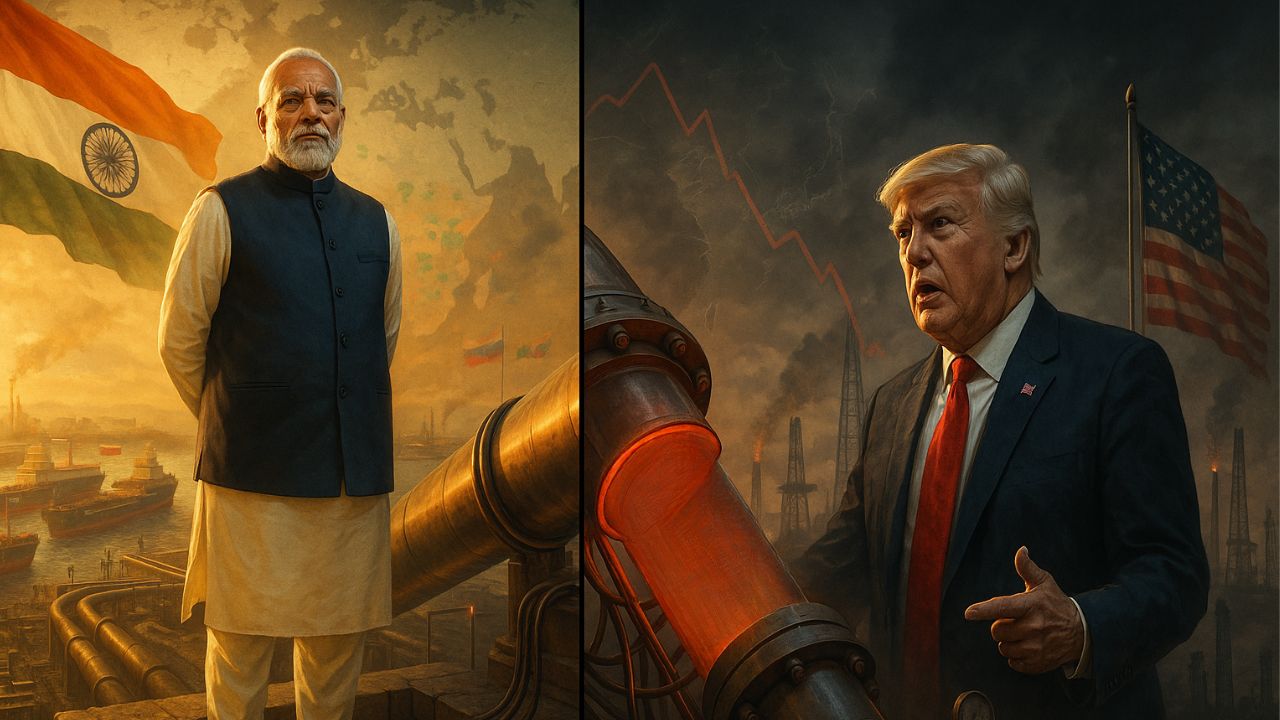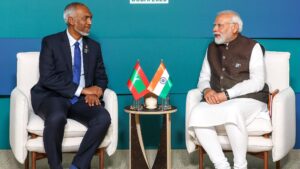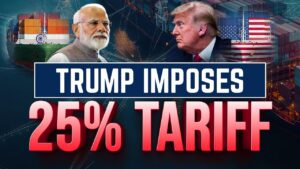I. Introduction
In the thick of a fractured global order, where alliances bend and economic interests redraw political lines, India stands at a precarious fulcrum. On one side: the enduring pull of strategic non-alignment and deepening ties with Russia. On the other: mounting pressure from the United States, now morphing into economic retribution. With the imposition of 25% tariffs on Indian exports and open warnings over its oil diplomacy, Washington’s message is clear — fall in line, or pay the price.
But Prime Minister Narendra Modi isn’t blinking.
Instead, he’s leaning in – invoking economic sovereignty, mobilizing a nationalistic “Buy Local” movement, and refusing to yield on what his administration frames as a sovereign right to choose its trade partners. In Modi’s India, decisions on oil imports aren’t dictated by Washington, but by energy security, inflation control, and domestic political calculus.
This blog unpacks the full story behind India’s bold defiance. We’ll explore why Russian oil has become indispensable to India’s economy, dissect the escalating trade conflict with the U.S., dive into Modi’s domestic strategy to cushion the blow, and examine how New Delhi is positioning itself in a world increasingly defined by polarization and power plays. Buckle in — geopolitics just got personal.
II. The Russia-India Energy Equation
Before 2022, Russian oil barely registered in India’s import basket, accounting for less than 1% of total crude purchases. By 2025, that figure has surged to nearly 40%, fundamentally altering India’s energy dynamics and its position in global politics.
From Marginal to Major
The shift began after the Ukraine conflict, when Western sanctions isolated Moscow and opened a path for Asian buyers. India, acting on commercial logic, capitalized on steep discounts from Russian suppliers. With prices averaging $10–15 below Brent crude, refiners quickly adapted. Both public and private sector players boosted Russian oil intake, driven not by ideology but economic necessity.
Energy Security First
For India’s 1.4 billion people, fuel prices are deeply political. Any increase triggers inflation, impacts daily life, and risks public unrest. Russian crude has played a critical role in stabilizing pump prices and shielding the economy from external shocks. It has helped contain inflation, preserve consumer confidence, and maintain momentum in a fragile global recovery.
Government officials insist the rationale is simple: these are market-based decisions. Energy procurement is tied to national interest, not geopolitical alignment. The calculus centers on affordability, security, and long-term resilience.
The Strategic Trade-Off
While critics argue closer ties with Russia may weaken India’s global positioning, New Delhi maintains that diversification is the core principle. By sourcing from multiple regions—Russia, the Middle East, Africa—India retains strategic flexibility. In a volatile world, autonomy in energy sourcing is not just practical, it’s essential.
The rise of Russian oil in India’s energy mix is not a defiant gesture. It is a strategic adjustment to new global realities.
III. US Pressure and Tariff Escalation
As India strengthens its energy relationship with Russia, the United States has shifted from quiet concern to overt pressure. President Donald Trump’s administration has framed India’s continued Russian oil purchases as incompatible with the spirit of US-India strategic cooperation. The result is a 25 percent tariff on a wide range of Indian exports, effective August 1, 2025.
Tariffs as Leverage
The tariff announcement was direct. It targeted sectors like textiles, automotive parts, and electronics, signaling Washington’s intent to use trade as a tool for geopolitical influence. US officials claim the move responds to what they describe as India’s imbalanced foreign policy, particularly its refusal to reduce Russian oil and defense imports. There have been clear warnings that additional penalties could follow.
The Political Undercurrent
Trump has been vocal in his frustration. He has accused India of weakening global sanctions against Russia and undermining Western efforts to isolate Moscow. Beyond oil, Washington is concerned about India’s increasing role within BRICS, its purchases of Russian weapons, and its broader independent foreign policy.
These tariffs are not just about trade. They are a signal that neutrality comes at a cost when it clashes with American strategic goals.
India’s Immediate Response
India has stood its ground. There has been no directive to refiners to limit Russian crude imports. The government maintains that procurement decisions are based on market logic, commercial viability, and national interest. Officials have repeated that energy security cannot be compromised by foreign pressure.
Despite the tension, trade talks between the two countries are ongoing. However, with both sides holding firm, progress remains slow and the gap in expectations is growing.
IV. Modi’s Defiant Response
While US tariffs aimed to force a policy shift, Prime Minister Narendra Modi has responded with calculated defiance. Instead of retreating, his administration doubled down—publicly affirming India’s right to make independent decisions and reinforcing a domestic campaign focused on economic self-reliance.
Standing Firm on Energy
Despite mounting pressure, the Modi government has issued no orders to halt or limit Russian oil imports. Indian refiners continue to buy based on pricing, availability, and strategic value. Officials frame these decisions not as acts of defiance, but as necessary steps to protect national interest. Energy policy, they say, must serve the people—not foreign agendas.
This refusal to bend has become a key talking point in Modi’s messaging. In recent public statements, he emphasized that global volatility cannot dictate how India runs its economy or fuels its growth.
Nationalism Meets Economics
To rally public support, Modi has revived the call for “Swadeshi”—buying and supporting locally made products. At a rally in Varanasi, he invoked Mahatma Gandhi’s legacy, urging citizens to embrace self-reliance as both a patriotic act and an economic shield.
This isn’t just symbolism. The renewed push under “Make in India” and “Vocal for Local” aims to reduce external vulnerabilities, especially as global trade tensions rise. Modi has positioned this movement as a defense against tariff shocks, while simultaneously fostering domestic innovation and job creation.
Strategic Messaging
The broader narrative Modi is crafting is one of unity and sovereignty. He’s urging the country to rise above partisanship and focus on building an economy resilient to global disruption. In this framing, continued trade with Russia isn’t a betrayal of alliances—it’s a rational choice in uncertain times.
By staying the course, Modi isn’t just defending an energy policy—he’s reinforcing a national identity grounded in independence, pragmatism, and resilience.
IV. Modi’s Defiant Response
While US tariffs were intended to force a strategic shift, Prime Minister Narendra Modi has responded with clear and deliberate resistance. Rather than scale back, his administration has publicly defended India’s right to make sovereign economic decisions, while launching a parallel campaign to strengthen internal resilience.
Standing Firm on Energy
Despite mounting international pressure, there has been no order from the Indian government to reduce or halt Russian oil imports. Refiners continue to purchase based on price, supply stability, and long-term strategic value. Officials insist these choices are driven by market logic, not ideology, and serve national interest first.
Energy policy, they argue, must ensure affordability and supply security for India’s population. Any decision influenced by external actors risks compromising both economic stability and public welfare.
Nationalism Meets Economics
To reinforce this stance, Modi has revived the idea of “Swadeshi”—a call to support domestically made products. Speaking in Varanasi, he invoked Mahatma Gandhi, linking self-reliance to both national pride and economic strategy. He positioned local consumption as a form of resistance against economic coercion.
This effort is not symbolic. Through Make in India and Vocal for Local, the government is promoting manufacturing, encouraging innovation, and working to insulate small and medium businesses from global market shocks.
Strategic Messaging
Modi’s messaging frames this as a unifying moment. He has urged citizens to set aside political differences and support an economy built on independence. Continued trade with Russia is being portrayed not as defiance, but as a pragmatic choice rooted in national security and economic logic.
By holding his ground, Modi is defending more than an oil policy. He is asserting India’s right to shape its own path, grounded in strategic clarity and national purpose.
V. The Domestic Push—Swadeshi and Resilience
As external pressure increases, the Modi government has responded by looking inward. The administration is channeling domestic sentiment into a focused campaign of economic self-reliance. The message is direct: India must build strength from within.
The Revival of Swadeshi
In response to tariffs and global tension, Modi has revived the idea of Swadeshi—India’s historic movement for economic independence. Originally born during the freedom struggle, it is now being redefined as a modern tool to resist foreign pressure. Modi has urged citizens to choose Indian-made products and link consumption with patriotism and national strength.
This message blends cultural memory with present-day urgency. By invoking Gandhi’s philosophy, the campaign connects tradition with contemporary economic policy and gives the public an active role in national resilience.
Make in India, Vocal for Local
These two flagship initiatives focus on building domestic manufacturing, reducing dependency on imports, and strengthening small and medium-sized enterprises. From mobile phones to agricultural tools, the aim is to increase production within India and secure essential supply chains.
This is not framed as isolationism, but as preparedness. The government is aligning policies, subsidies, and tax incentives to promote industries that are most exposed to external shocks.
Building Economic Immunity
The broader goal is to make India less vulnerable to global disruptions. By supporting local supply chains, encouraging domestic alternatives, and promoting innovation, the campaign is designed to absorb future economic shocks more effectively.
Modi has framed this movement not as a short-term adjustment, but as a national responsibility. For his government, economic resilience is not just a strategy—it is a necessity for long-term stability.
VI. Trade Talks and Strategic Deadlock
Amid rising tariffs and public posturing, India and the United States remain locked in ongoing trade negotiations. While both sides express a desire for resolution, progress has been minimal. At the core of the impasse lies a fundamental clash of priorities.
Ongoing but Stalled
Talks continue, but with limited momentum. The United States is pressing for broader market access, particularly in agriculture, dairy, and digital services. It wants India to lower tariffs and open sectors that have long been protected by policy and politics. In return, India is seeking relief from the new 25 percent tariffs and more flexibility for its service exports, including tech and pharmaceuticals.
Despite several high-level meetings, outcomes have been sparse. Each side is holding firm, unwilling to concede on areas that impact core constituencies.
India’s Red Lines
For India, certain issues are non-negotiable. The government has made it clear that it will not compromise on the interests of farmers, small industries, or rural communities. These sectors are not only economically vital, but politically sensitive. Making concessions here would carry a high domestic cost.
Officials also reject any suggestion that trade access should be linked to foreign policy alignment. They insist that energy and defense procurement decisions, including those involving Russia, are based on sovereign calculations, not transactional diplomacy.
Strategic Caution
India continues to engage with the US, but it is doing so with caution. Publicly, the government emphasizes cooperation and shared values. Privately, it is preparing for a longer standoff. The broader tone is pragmatic. India is willing to talk, but not at the expense of strategic autonomy or domestic stability.
With both sides unwilling to move on key demands, the trade talks have reached a delicate standoff. Dialogue remains open, but resolution remains distant.
VII. India’s Economic Positioning
Amid rising tariffs and public posturing, India and the United States remain locked in ongoing trade negotiations. While both sides express a desire for resolution, progress has been minimal. At the core of the impasse lies a fundamental clash of priorities.
Ongoing but Stalled
Talks continue, but with limited momentum. The United States is pressing for broader market access, particularly in agriculture, dairy, and digital services. It wants India to lower tariffs and open sectors that have long been protected by policy and politics. In return, India is seeking relief from the new 25 percent tariffs and more flexibility for its service exports, including tech and pharmaceuticals.
Despite several high-level meetings, outcomes have been sparse. Each side is holding firm, unwilling to concede on areas that impact core constituencies.
India’s Red Lines
For India, certain issues are non-negotiable. The government has made it clear that it will not compromise on the interests of farmers, small industries, or rural communities. These sectors are not only economically vital, but politically sensitive. Making concessions here would carry a high domestic cost.
Officials also reject any suggestion that trade access should be linked to foreign policy alignment. They insist that energy and defense procurement decisions, including those involving Russia, are based on sovereign calculations, not transactional diplomacy.
Strategic Caution
India continues to engage with the US, but it is doing so with caution. Publicly, the government emphasizes cooperation and shared values. Privately, it is preparing for a longer standoff. The broader tone is pragmatic. India is willing to talk, but not at the expense of strategic autonomy or domestic stability.
With both sides unwilling to move on key demands, the trade talks have reached a delicate standoff. Dialogue remains open, but resolution remains distant.
VIII. The Bigger Picture: India’s Sovereign Strategy
At the heart of India’s response to US pressure lies a deeper strategic philosophy. The Modi government is not treating the Russian oil issue or the tariffs as isolated incidents. Instead, it is presenting them as part of a broader effort to assert India’s autonomy in a divided and shifting global landscape.
Multipolar Vision
India positions itself not as a subordinate to any single power but as an independent force in a multipolar world. Its continued involvement in BRICS and sustained cooperation with Russia reflect this approach. India maintains active ties with both the West and the Global South, aiming for balanced partnerships rather than fixed alignments.
This view is not new. It extends India’s legacy of non-alignment, now adapted to the realities of a globalized economy. Decisions on energy, defense, and trade are guided by national interest, not external pressure. The focus is on diversification and risk management.
Strategic Autonomy
Sovereignty remains central to India’s foreign policy doctrine. Across diplomatic and public platforms, officials have reiterated that key decisions will be made in Delhi. Procurement strategies, global alliances, and economic frameworks are crafted to serve India’s independent vision.
This principle allows India to engage globally while safeguarding domestic priorities. It also ensures flexibility in navigating changing geopolitical dynamics without sacrificing core interests.
Energy Security as Policy
Russia’s role in India’s energy mix is viewed through a policy lens, not a political one. With Russian crude offering price advantages, maintaining these imports is seen as essential to stabilizing fuel costs, managing inflation, and sustaining growth. The government sees securing affordable energy as a direct responsibility to its citizens.
From this perspective, the refusal to reduce Russian oil imports is not an act of defiance. It is a strategic decision grounded in national interest. India is signaling that while it welcomes cooperation, it will not compromise on essential economic or security concerns.
IX. Conclusion
India’s response to escalating US pressure reveals more than a policy disagreement. It reflects a broader assertion of sovereignty, strategy, and self-confidence. By continuing oil imports from Russia, rejecting tariff-linked concessions, and launching a domestic economic push, the Modi government is sending a clear message—India’s interests will be defined at home, not abroad.
This is not a break from diplomacy but a recalibration. India remains engaged with the United States and other partners, but on its own terms. It is leveraging economic strength, political will, and a long-standing tradition of non-alignment to navigate one of the most complex global environments in recent history.
As trade talks stall and tariffs rise, India is betting on resilience. It is doubling down on domestic manufacturing, expanding global partnerships beyond the West, and asserting its right to pursue an independent foreign and energy policy.
In this moment of geopolitical strain, India is not choosing sides. It is choosing itself
Frequently Asked Questions
1. Why is India still buying oil from Russia despite U.S. sanctions?
India continues importing discounted Russian crude to manage inflation and ensure long-term energy security. The government maintains that these purchases are driven by national interest and economic logic, not geopolitics.
2. What are the U.S. tariffs on India in 2025 and why were they imposed?
In August 2025, the U.S. imposed a 25% tariff on Indian exports like textiles and electronics. The move was in response to India’s ongoing oil imports from Russia and its growing defense and economic ties with Moscow.
3. How has PM Modi responded to U.S. pressure over Russian oil imports?
Prime Minister Modi has refused to back down, reaffirming India’s sovereign right to choose its energy partners. He continues to support Russian oil imports and promotes self-reliance through campaigns like ‘Swadeshi’ and ‘Make in India.’
4. What is India’s Swadeshi movement and how does it relate to the Russia oil issue?
Swadeshi is a nationalist economic policy encouraging the consumption of Indian-made goods. Modi has revived it to strengthen domestic manufacturing and reduce reliance on imports—particularly in response to rising global tariffs and supply chain risks.
5. How does India’s oil trade with Russia impact India–U.S. relations?
India’s growing energy and defense ties with Russia have created friction with the U.S., especially under Trump’s leadership. While trade talks continue, India’s insistence on strategic autonomy is redefining its role in a multipolar world order.




